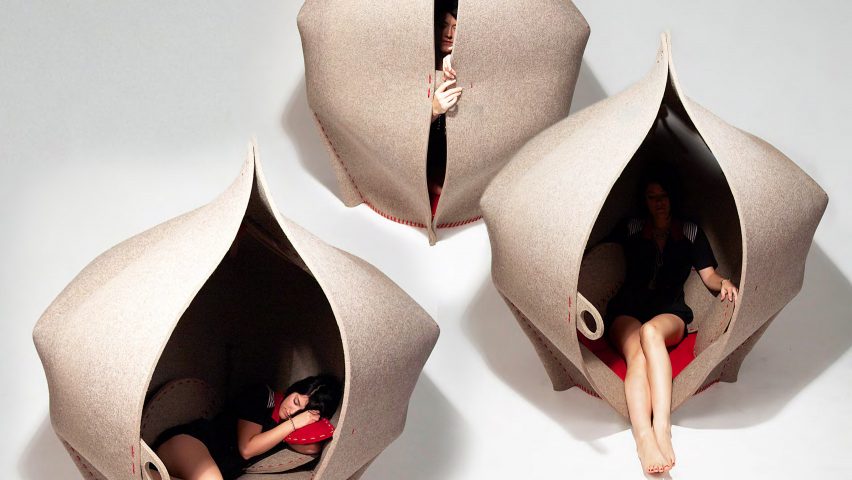Pods are more popular than ever but offer far more than merely a place to take a call in a busy office, writes Freyja Sewell.
Like mushrooms after a damp night in autumn, it seems pods are popping up everywhere lately. From fuzzy booths for private phone calls to high-tech, egg-shaped meditation chambers and sound-insulated cylinders in co-working spaces, it seems to me that pods have quietly become a standard part of our open-plan interior landscape.
It might seem that this furniture category should be newly inserted between lamps and sofas, but, just like those mushrooms, they are actually the recent fruit of a much longer and larger underground network, an epoch spanning design history but little discussed. As both a fan and a designer, please allow me to reveal the potent power of the pod.
Pods are a tool of consciousness exploration
Our story starts, as many good human stories do, in the cave. In many ancient cultures, including that of China and Greece, caves served as shelters where religious devotees could separate themselves from society. A human amongst other humans is subject to social conformity, but by entering a pod-like cave the human is liberated from this pressure, entering into a state of unobserved freedom.
A deep, natural cave is pitch black and almost entirely sound-proof. Without the "objective noise of sensory correction or reality testing, consciousness focuses solely on the subjective self", to quote Yulia Ustinova's book, Caves and the Ancient Greek Mind: Descending Underground in the Search for Ultimate Truth. Pods are a tool of consciousness exploration.
This idea was much further developed by an important design figure in today's whirlwind history: John C Lilly, creator of the first isolation tank in 1954. Lilly's tank was a box-like construction of vinyl-lined plywood. It would undergo many transformations before arriving at the smooth organic forms you may be familiar with at your local commercial Floatworks.
Pods are devices to travel internally, but they are also a critical part of external exploration, from Alexander the Great's underwater escapades in the 16th century to Yuri Gagarin's in 1961, who became the first human to leave, and return to, our planet. The forms of early spaceships, and indeed the images of our curved blue-ball Earth, would inspire a heady age for pods – the space-age design launched in the 1960s.
There are far too many pods to introduce in detail here, so I'll just mention a couple of my favourites. How about the Archigram Cushicle, a wearable, spacesuit-inspired pod? And Haus Ruckers' classic Balloon for 2, which took the form of a delicate bubble unfurling from a pre-war Viennese apartment building. Without damaging or destroying the old, a bubble of privacy in a public sphere was created. And we must of course make room for the iconic Ball Chair by Eero Aarnio.
We arrive in the 1970s to another time crucial to the history of pods, the Metabolist movement. Kisho Kurokawa and his fellow architects, designers and thinkers sought to reinterpret the urban environment as a living whole, a complex network of responsive and interlinked parts. As the human body repairs and replaces individual cells to maintain the whole, so the city becomes a living and adaptable system of capsules comprised of still more capsules.
Privacy has become an even more elusive and rare condition
Kurokawa saw these capsules, his chosen word for pod, as spaces where the "characteristics and feelings of the individual human being" could be restored against the unification of modernisation and mass manufacture. In his own words: "The capsule is defined as a space which guarantees complete privacy for the individual. It assures the physical and spiritual independence of the individual."
I believe this to be a beautifully articulated understanding of what pods can achieve, and it also offers some explanation as to why we see pods proliferating at such a pace around us today. After all, privacy has become an even more elusive and rare condition, with pervasive CCTV, the rise of open-plan offices and the pressure to record and share almost every moment through the ubiquitous camera phone.
I certainly felt this pressure in university, and it spurred me to offer my own contribution to the history of pods, with the Hush chair in 2011. I craved something softer and more environmentally sensitive than the beautiful but plastic-heavy offerings of the 1960s and '70s. After much experimentation I settled on felt and a biophilic form that could be fully closed to provide the privacy and protection I craved and wanted to facilitate.
In 2015 humans officially became an urban species, with more people living in cities than outside. We can now choose from an almost dizzying array of commercially available pods to suit our needs. Many new pods, for example an offering by Headspace, combine our modern understanding of neuroscience and mediation with the physical properties of privacy in the public sphere. The Somadome Pod builds on the work of Lilly and Haus Rucker, with trance-inducing light and sound displays.
As a pod fan and builder I'm delighted. I have curled up in many for naps and solitude in our hectic shared spaces. I hope this (very) brief history will encourage you to keep your eyes peeled for one near you to snuggle up inside, so you may also experience the power of the pod.
Freyja Sewell is an interdisciplinary designer and artist whose work focuses on a biophilic vision of the future.
Dezeen In Depth
If you enjoy reading Dezeen's interviews, opinions and features, subscribe to Dezeen In Depth. Sent on the last Friday of each month, this newsletter provides a single place to read about the design and architecture stories behind the headlines.

